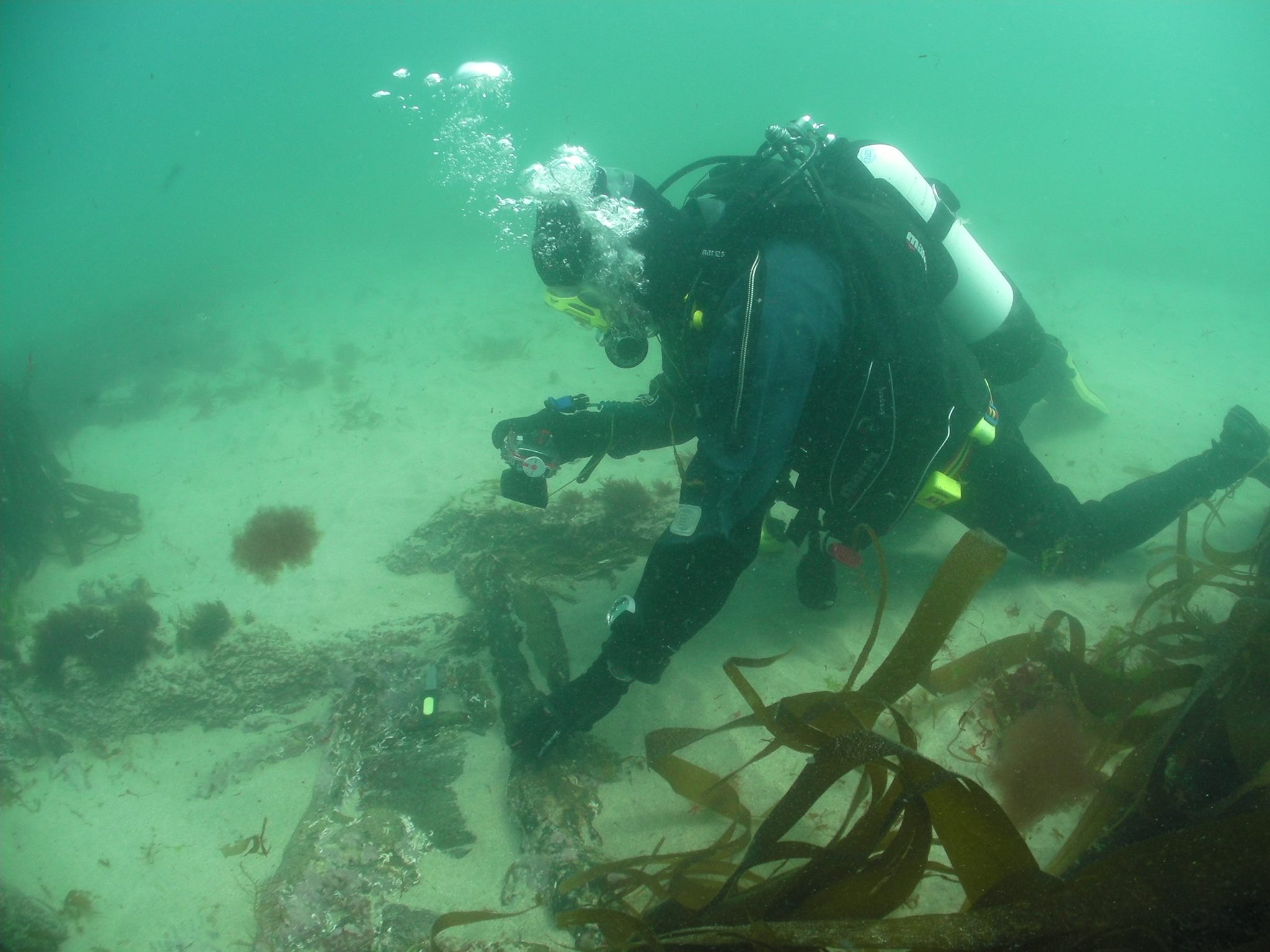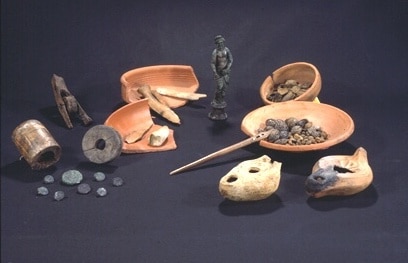News
Mark Milburn’s Cornish Wreck Ramblings, Part 10: Ancient Times

Cornwall is well known for its tin mining industry; the iconic engine houses can still be seen around the countryside. It is an ancient industry, starting well over 2,500 years ago. Production of tin, a constituent of bronze, was important worldwide especially during the bronze age. This brought traders. There is a rumour that the Phoenicians came to Cornwall to trade for tin, although there has been no evidence to prove that, yet. On an old hand drawn local chart, in an area near St Michael’s Mount, there is a written comment stating ‘Phoenician’s objects found’. What these ‘objects’ were, or where they are now, is unknown.

 Whether the Phoenicians actually made it to Cornwall may never be known. The author David Gibbins writes of a Phoenician wreck off the Cornish Coast in his book Testament. Although Testament is fiction, several of David Gibbins stories from his books have actually come true. Whether or not the Phoenicians came to Cornwall, there would have been other traders coming by sea, from that era.
Whether the Phoenicians actually made it to Cornwall may never be known. The author David Gibbins writes of a Phoenician wreck off the Cornish Coast in his book Testament. Although Testament is fiction, several of David Gibbins stories from his books have actually come true. Whether or not the Phoenicians came to Cornwall, there would have been other traders coming by sea, from that era.
The Romans may have conquered a large part of the known world, including England. They did not conquer Cornwall, although they did trade with her. There are very few known Roman settlements in Cornwall, it was too remote and the Cornish were probably too efficient at producing tin. The Romans knew that if they tried to take control, tin production might fall. It was far easier to trade.
There are lots of Roman finds around Cornwall; a lot, considering they never really occupied the area. Roman tin traders would have travelled by land as well as by sea. Rumours of Roman wrecks have been passed down locally and amphora are believed to have been recovered in the past. I have been told this from two separate sources with regards to two separate locations. There is a very big chance that there are more to be found.

 Apart from amphora, we would expect to see remains of weapons and even quern stones. Quern stones are corn grinding stones, something the Romans were believed to carry on all their vessels. They would be used for grinding corn to make flour, which they could use to make bread, soups or cornmeal. I have found a quern stone, as has another local diver. They are hard to date but are both estimated to be over a thousand years old. They would also have a hearth, terracotta and bronze containers and utensils, maybe even a mortar. Roman warships had large bronze spikes at the bow to pierce any vessels they rammed, but, unfortunately, their merchant vessels did not have these.
Apart from amphora, we would expect to see remains of weapons and even quern stones. Quern stones are corn grinding stones, something the Romans were believed to carry on all their vessels. They would be used for grinding corn to make flour, which they could use to make bread, soups or cornmeal. I have found a quern stone, as has another local diver. They are hard to date but are both estimated to be over a thousand years old. They would also have a hearth, terracotta and bronze containers and utensils, maybe even a mortar. Roman warships had large bronze spikes at the bow to pierce any vessels they rammed, but, unfortunately, their merchant vessels did not have these.
The Vikings visited Cornwall, not to live, but to raid and trade. They made several raids including one as far around the coast as Padstow in 981AD. They would have traded for tin as it was still an important commodity. Viking ships were fast but lightweight and constantly needing repair. Riding a storm out on the Cornish coast is hard in any small vessel, so the Viking vessels would stand little chance. Unfortunately, there was little to a Viking ship, other than wood and small iron nails. So, if one was ever found, it would be very hard to work out what it was from the cargo alone. Although finding anything ancient in the waters around Cornwall would be highly unlikely, it would certainly be of national archaeological importance.
Find out more about Mark and Atlantic Scuba at www.atlanticscuba.co.uk
News
Book Review: Fire on Monroe Bravo by Fred Lockwood

Fire on Monroe Bravo is the latest book in the Jack Collier series by Fred Lockwood. Our story begins with our lead characters, Jack and Sandro, owners of Marine Salvage & Investigation Company, arriving on the Monroe Bravo Oil & Gas Platform in the North Sea. Having secured a contract for their vessel the MV Stavanger to act as support ship to the platform for TransGlobal Oil, our protagonists are on a celebratory visit.
However almost as soon as they arrive a series of explosions rock the platform, causing huge damage, loss of life and the very real danger of a massive human, ecological and financial disaster.

As the danger mounts for both our heroes and the surviving workers, Jack and Sandro will have to escape the inferno, all while trying to save the platform and the men still trapped unable to help themselves.
The disaster sets the scene for the unfolding story lines following the fate of the platform and our main characters, the police investigation into a suspected terrorist act and the actions of TransGlobal Oil as they attempt to navigate the pubic outcry and financial repercussions.
In his eighth book, Fire on Monroe Bravo, Fred Lockwood delivers an explosive thriller, with plenty of above and in-water drama, and our heroes fighting for survival, what more can you ask for?
We thoroughly recommend this read and look forward to the next in the series. For more information about his book series, you can check out the reviews of his previous books here on Scubaverse.
- Title: Fire On Monroe Bravo
- Author: Fred Lockwood
- ISBN: 979-8325324536
Available in a paperback version and for Kindle from Amazon and book stores.
Blogs
Alonissos: The complete diving destination (Part 1)

In June we were incredibly fortunate to be invited to dive in Alonissos, a small Greek Island in the Sporades island chain located in the North Aegean Sea. While I have long been a big fan of the Greek Islands as a great holiday destination, I had not had the opportunity to do any diving on previous visits and Mike and I were extremely excited to see what Alonissos had to offer both above and below the surface!

The Sporades are easily accessible via the airport in Skiathos (the first island in the chain), which is served by Jet2 flights from all major UK airports from May through October. Numerous ferries and charter boats make island hopping from Skiathos Town a breeze. After an hour boat ride, the picturesque port of Patitiri was a wonderful introduction to Alonissos, where we were met by our gracious hosts Kostas of Albedo Travel and Dias of Alonissos Triton Dive Center. Mike and I were delighted to be staying at the Paradise Hotel, aptly named for its stunning views over the sea and great location for walking to the waterfront.

Alonissos is beautifully situated in the National Marine Park of Alonissos and the Northern Sporades, the largest marine protected area in Europe. The surrounding seas offer fabulous marine life, including incredibly rare species such as the Mediterranean monk seal. They boast deep walls covered in gorgonians and sponges, stunning topography with caverns, swimthroughs and pinnacles, and the first accessible ancient shipwreck from 500BC!

In locations where historical sites have been reported, the waters are largely restricted, but with collaboration between government, underwater archeologists and dive centres, incredible underwater museums are being created for a truly unique diving experience. Alonissos is home to the first of these, the Ancient Shipwreck of Peristera Accessible Underwater Archeological Site. The chance to dive into history (along with reports of healthy reef life and amazing underwater topography) meant Mike and I were keen to get in the water.

Our introduction to the diving around Alonissos was at the Agios Georgios Pinnacles, in the channel between Alonissos and Skopelos. This fantastic site was named “The Chimney,’ and proved to have a huge amount to see. We got to a decent depth here (over 25m), and marvelled at a colourful reef wall with a wonderful swim through whose rocky walls were absolutely covered with life. As well as brilliant topography there was no shortage of macro life here. We saw numerous nudibranchs, five different species in total. The second dive at Mourtias reef nearby was a shallower dive along a nice wall with lots of crevices. Several moray eels and grouper called this site home. We enjoyed looking in the crevices for lobster and smaller benthic life, such as cup corals and tunicates.

Our itinerary allowed us two dives a day with afternoons left to explore the island with our hire car and evenings to enjoy the famous Greek hospitality. This proved to be a lovely mix of in-water and land based diversions.

The next days diving to the Gorgonian Gardens and Triton’s Cave was to be even better! These two stunning sites are nothing short of fabulous. The Gorgonian Gardens was a deep wall near to the Agios Georgios islands. The ever-present currents in this deep channel meant that the sea life was amazing … the namesake Gorgonian sea fans dotted the wall at a depth of 30 to 50 meters, getting ever larger the deeper we went. Above 30m was by no means less beautiful, with sponges, corals, scorpionfish, moray eels and some rare and colourful nudibranchs.

The second shallower dive of the day was to Triton’s Cave or the Cavern of Skopelos, on the east side of that island. The spectacular rock formations had wild striations both above and below the water making a truly epic topography. The cavern entrance was at 14m, and big enough for a buddy pair, winding up to 6m and passing two beautiful windows out into the blue. Emerging from the cavern, the light at the shallower depths and the incredible rock formations made for a fantastic gentle swimming safety stop and we all surfaced by the boat with massive grins.

Check out our next blog :Alonissos: The complete diving destination (Part 2)” to hear about our amazing dive on the 2500 year old Peristera Wreck!
Thanks to:
Alonissos Triton Dive Center https://bestdivingingreece.com/
Albedo Travel https://alonissosholidays.com/activities/
Paradise Hotel https://paradise-hotel.gr/
Alonissos Municipality https://alonissos.gr/en/
-

 Blogs2 months ago
Blogs2 months agoDiving With… Nico, Ocean Earth Travels, Indonesia
-

 News1 month ago
News1 month agoMurex Bangka Announce New Oceanfront Cottages & Beachfront Dining
-

 Blogs2 months ago
Blogs2 months agoA new idea in freediving from RAID
-

 Marine Life & Conservation1 month ago
Marine Life & Conservation1 month agoIceland issue millionaire whale hunter a licence to murder 128 vulnerable fin whales
-

 Marine Life & Conservation2 months ago
Marine Life & Conservation2 months agoThe Shark Trust Great Shark Snapshot is back
-

 News3 months ago
News3 months agoCharting New Waters; NovoScuba Goes Global with the Launch of their Revolutionary Dive Training Agency!
-

 Gear News1 month ago
Gear News1 month agoNew Suunto Ocean – a dive computer and GPS sports watch in one for adventures below and above the surface
-

 Marine Life & Conservation Blogs2 months ago
Marine Life & Conservation Blogs2 months agoBook Review: Plankton















